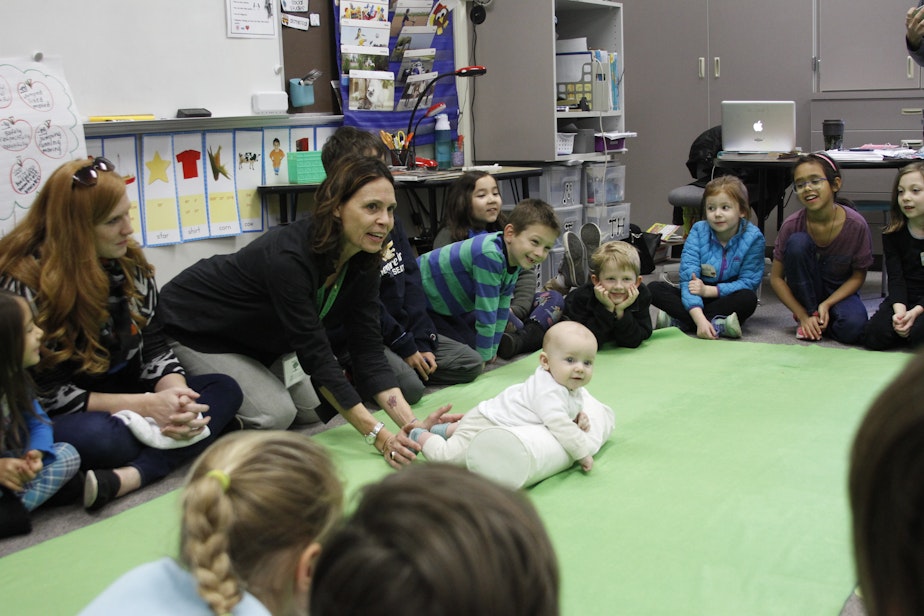This baby teaches empathy to second-graders

Not every teacher wears a onesie, diaper and gets greeted with a song.
"Hello Baby Declan, how are you today?" sings a roomful of second-graders to 5-month-old Declan on his monthly visit to Highland Terrace Elementary in Shoreline.
The students sit in a circle on the floor. Their eyes are glued to their tiny guest.
These visits are part of Roots of Empathy. This international program brings babies to classrooms to help students think more about other people’s emotions – and their own.
Roots of Empathy instructor Rebecca Young asks the class to pay attention to Declan’s body language.
Sponsored
Rebecca Young: “Tell me how you think he’s feeling? Andy?
Andy: “Happy.”
Rebecca Young: “What tells you that? Luke?”
Luke: “The expression on his face. He’s smiling right now.”
The children note that Declan’s legs are much stronger than last month. And his hands are opening up – no more clenched fists. Young asks the class how they’d characterize Declan’s general disposition.
Sponsored
“He seems pretty sunny, doesn’t he?”
Class: “Yeah!”
Young: “In this room, how many of you feel that you’re sort of high on the sunny mood side of things? Okay, so quite a few of you. And what about those of you who feel you’re just a little more serious in your mood? That’s a temperament trait, just like activity level, and we can see this guy is quite active these days.”
Roots of Empathy has been shown in numerous studies to increase students’ compassion toward their peers, and reduce aggression. The program began in Canada.
Over the past two decades it’s expanded to ten countries, and three languages. Young says she became an instructor for the program after seeing its effect on her own young son.
Sponsored
Young: “He’s really empathic and I think he got that so early on. It stayed with him.”Declan's mom, Jill Mitchell, shows the students what’s in her diaper bag, and how she knows what he wants at a given time – from a fresh diaper, to a pacifier. Young: “Let’s sing a song to our bouncing baby. Maybe a bouncing song and we’ll see how he reacts.”
Declan squeals, and the students laugh.
Rebecca Young: “Do you think he wants us to sing to him?”
Class: “Yeah!”
In between visits from Declan, Young comes to the class to talk about feelings. Students do art projects and other lessons to explore the highs and lows they experience themselves.
Sponsored
Whitney Burgett teaches this second-grade class. She says in the few months, baby Declan has been coming to the class, she’s already seen students treating each other more gently and cooperatively.
Burgett says being able to experience feelings along with a baby makes all the difference for kids.
Burgett: “They’re taking what they’re learning about the baby and putting it into their own lives.”
Back in the classroom, baby Declan is wilting a little bit.
"What do you think he’s telling us?"
Sponsored
"He’s tired?"
"How did you know he’s tired?"
"He put his head down."
Highland Terrace principal Jacqueline Estephan says she’s happy with the strategy to put Roots of Empathy into every second grade classroom in the school this year.
Estephan: “All the reading I’m doing around how can we make our schools a safe place for children is all about the proactive and the preventative approaches. That’s what Roots of Empathy is.”

